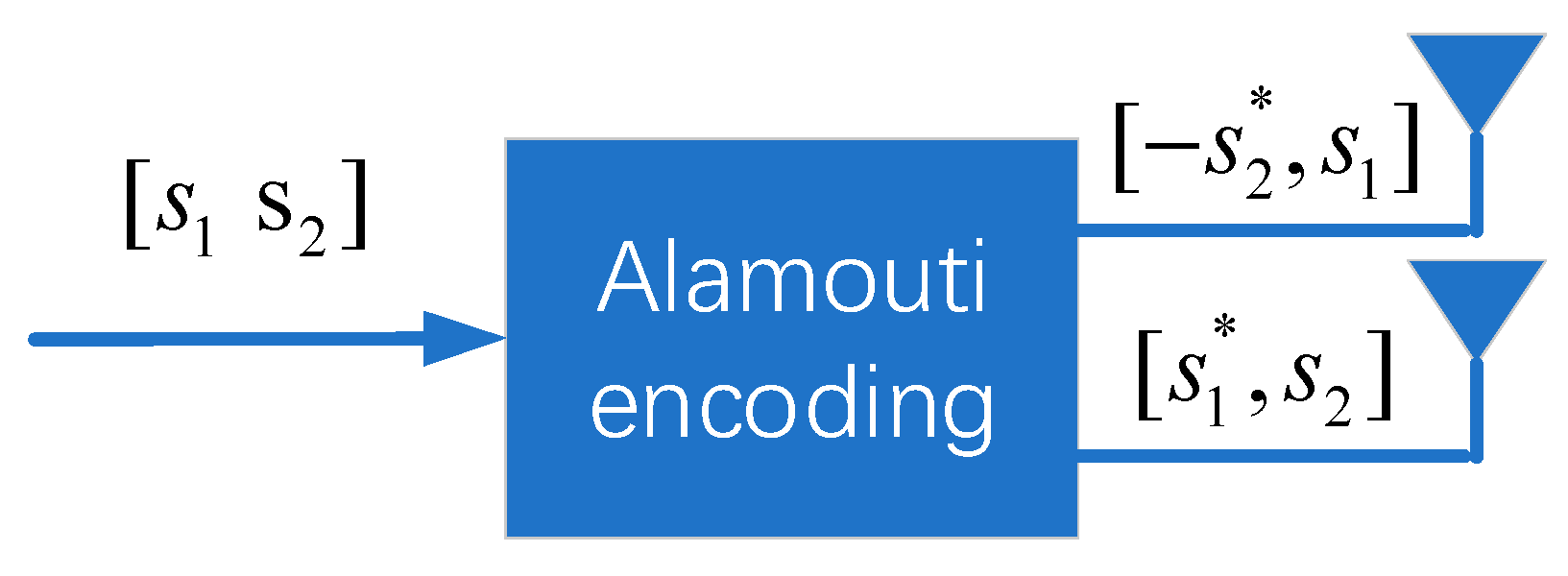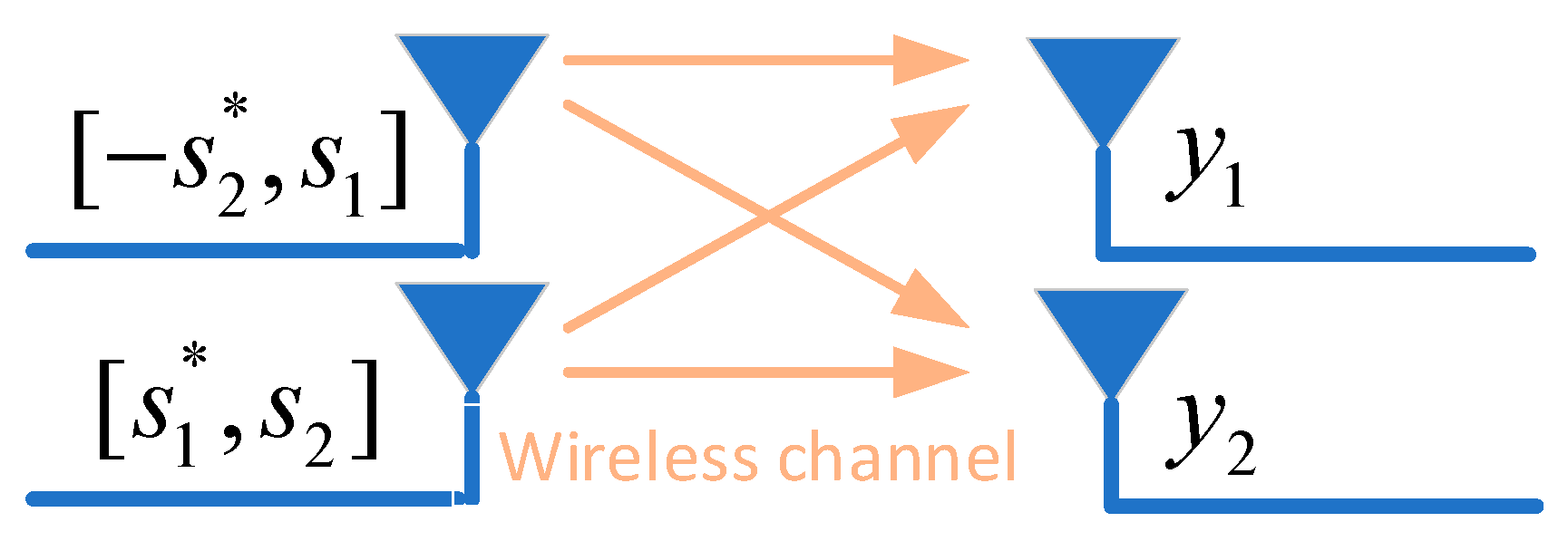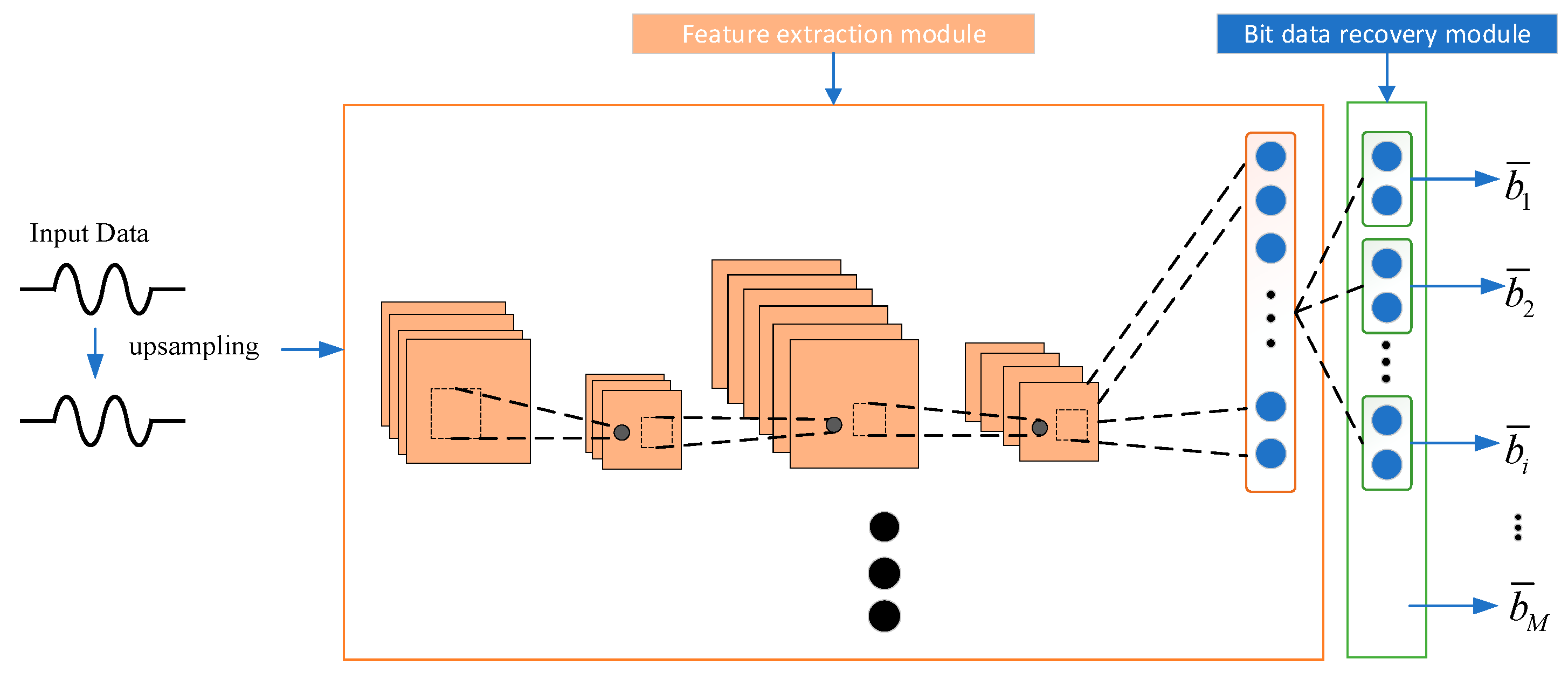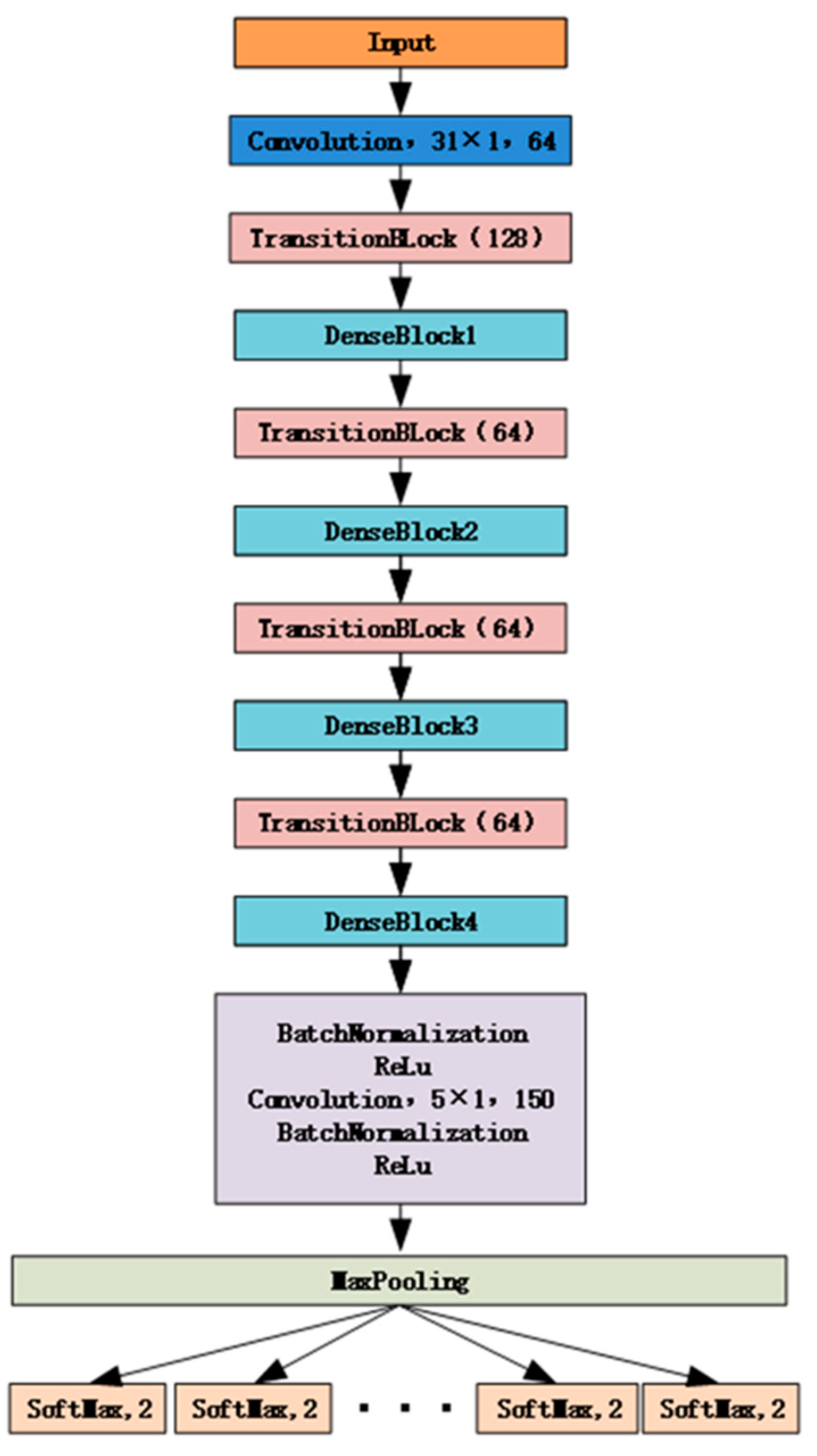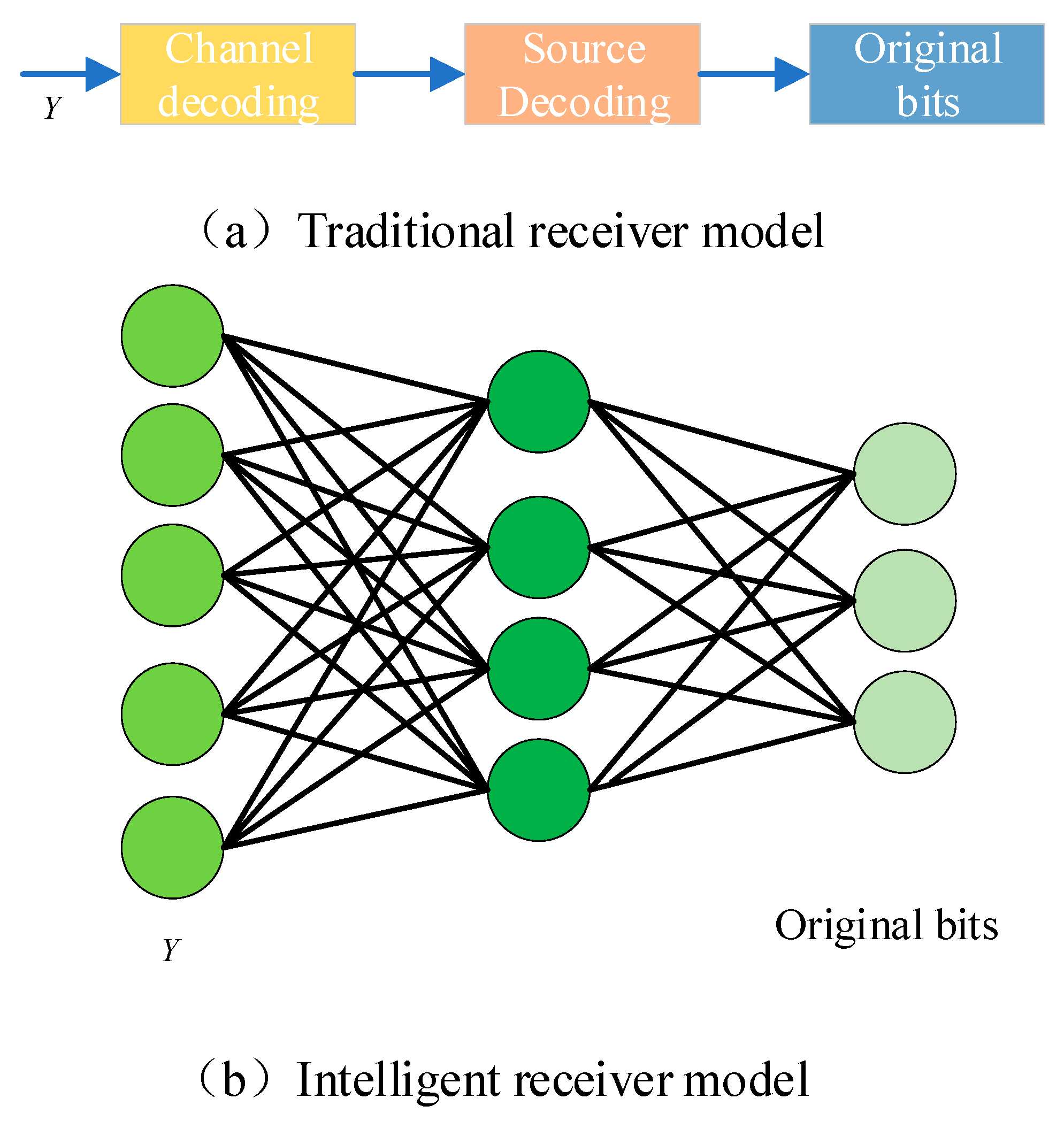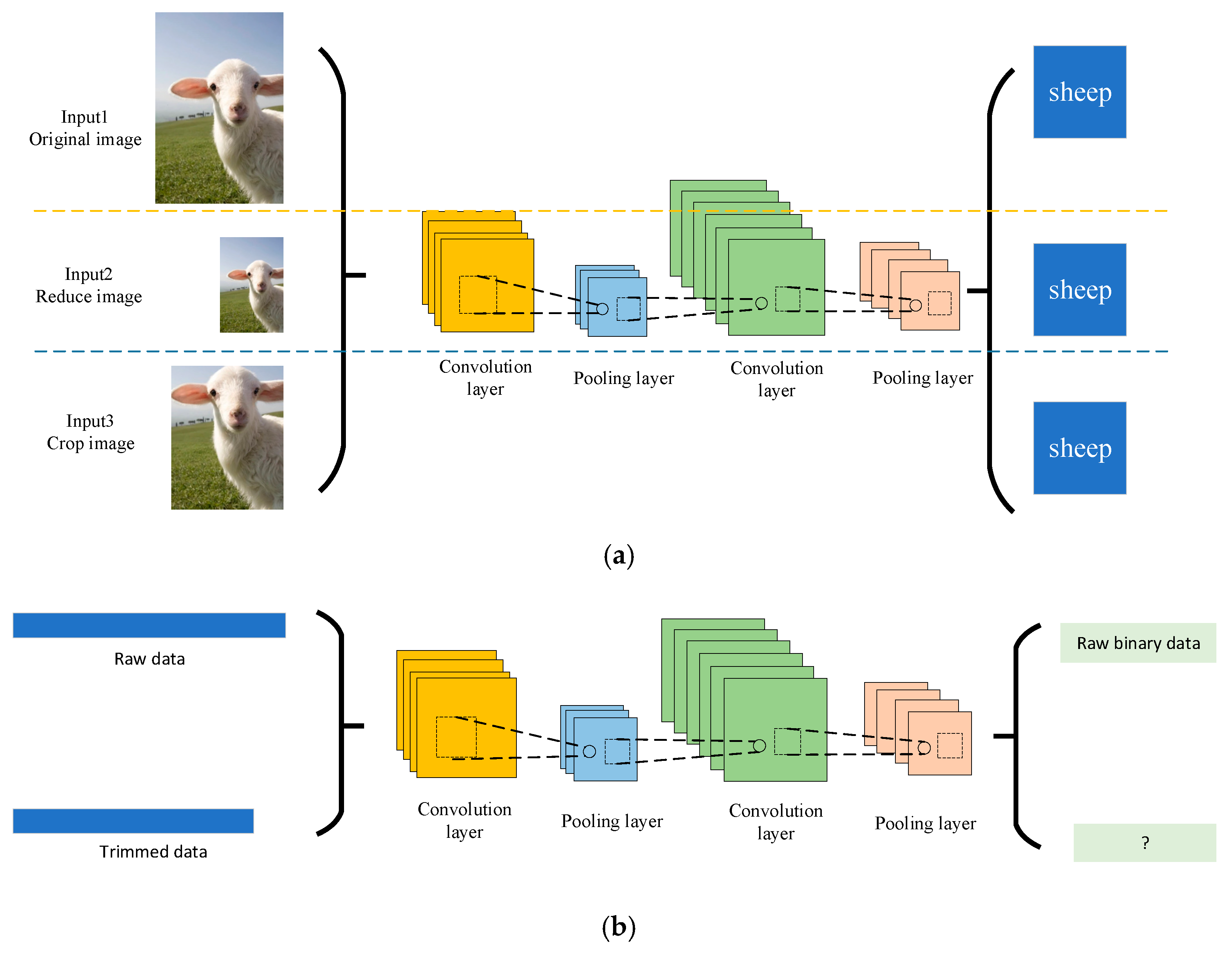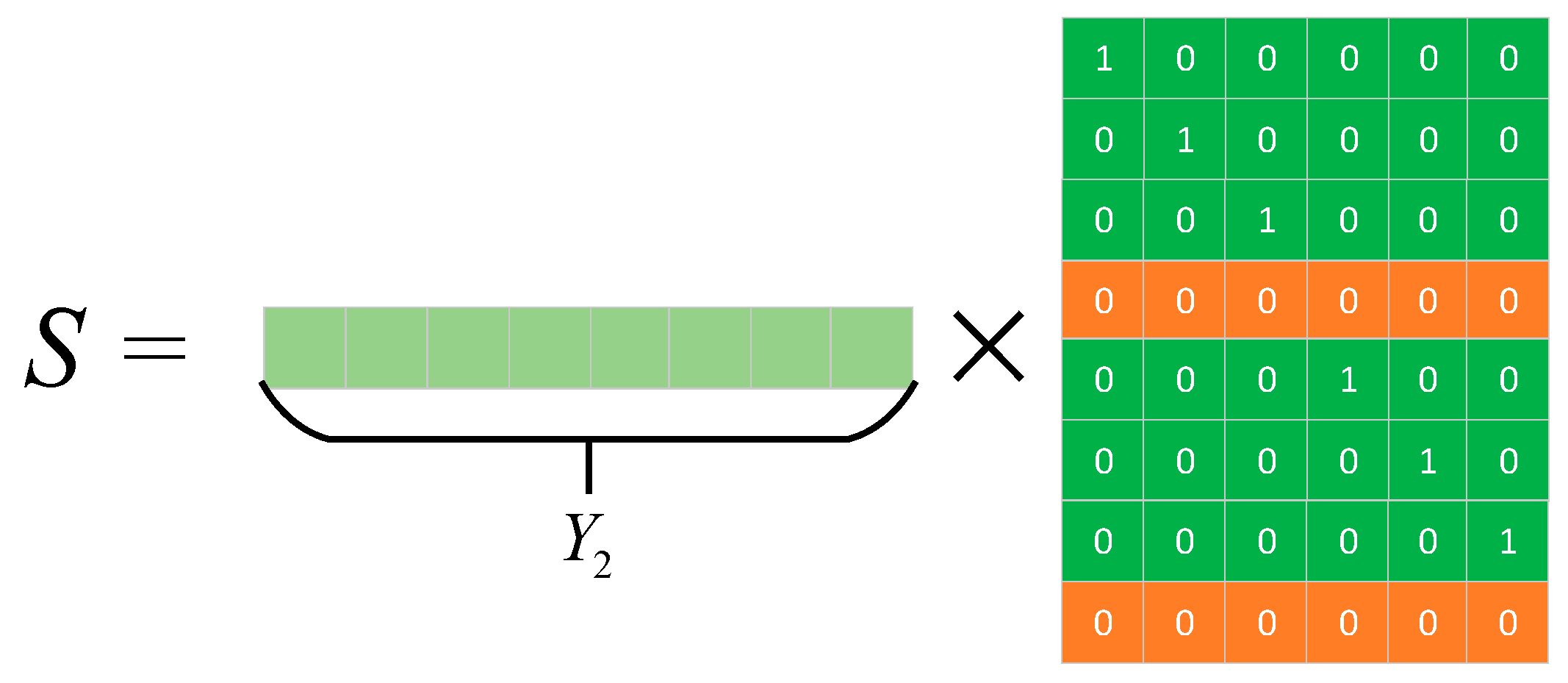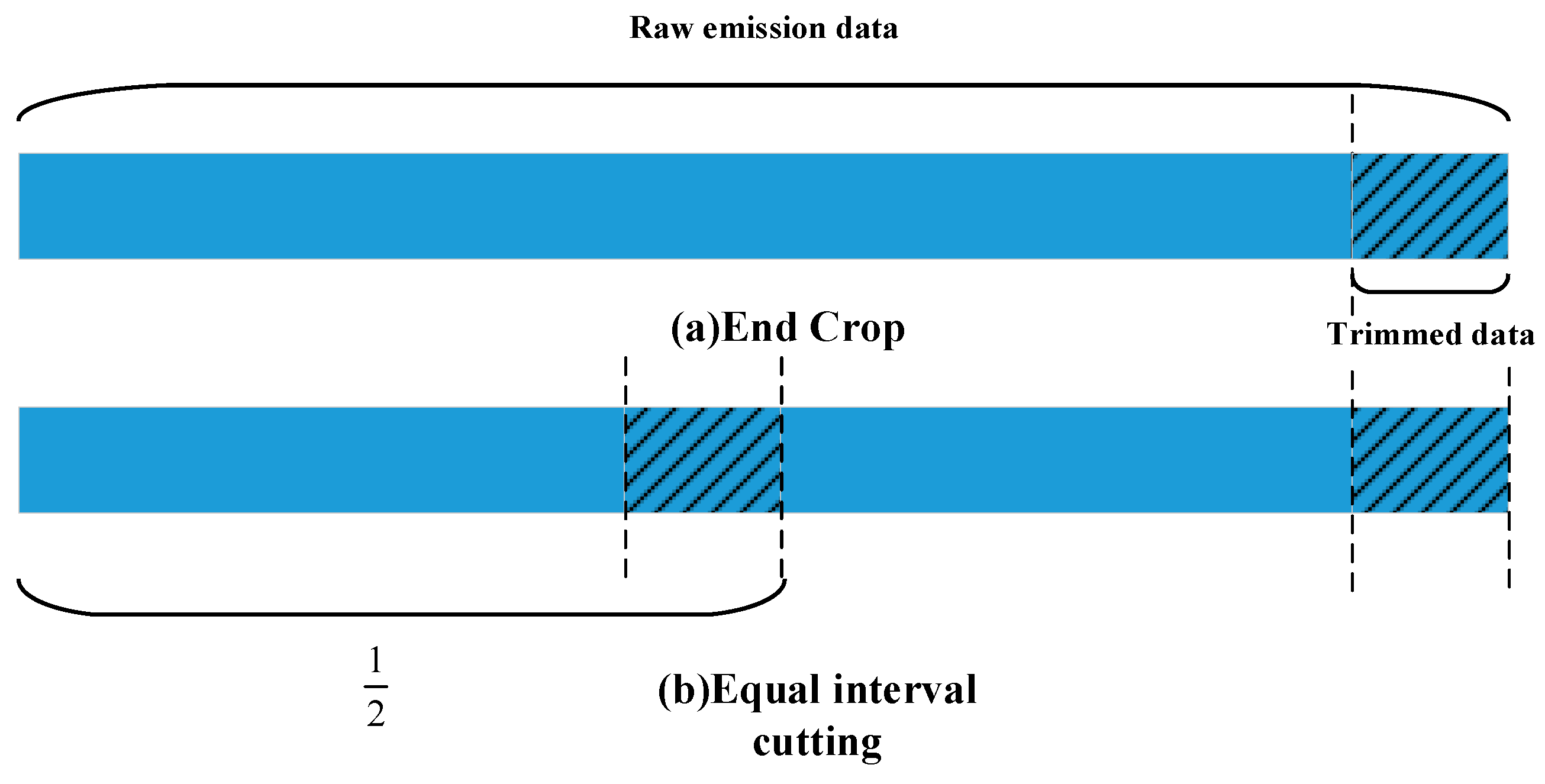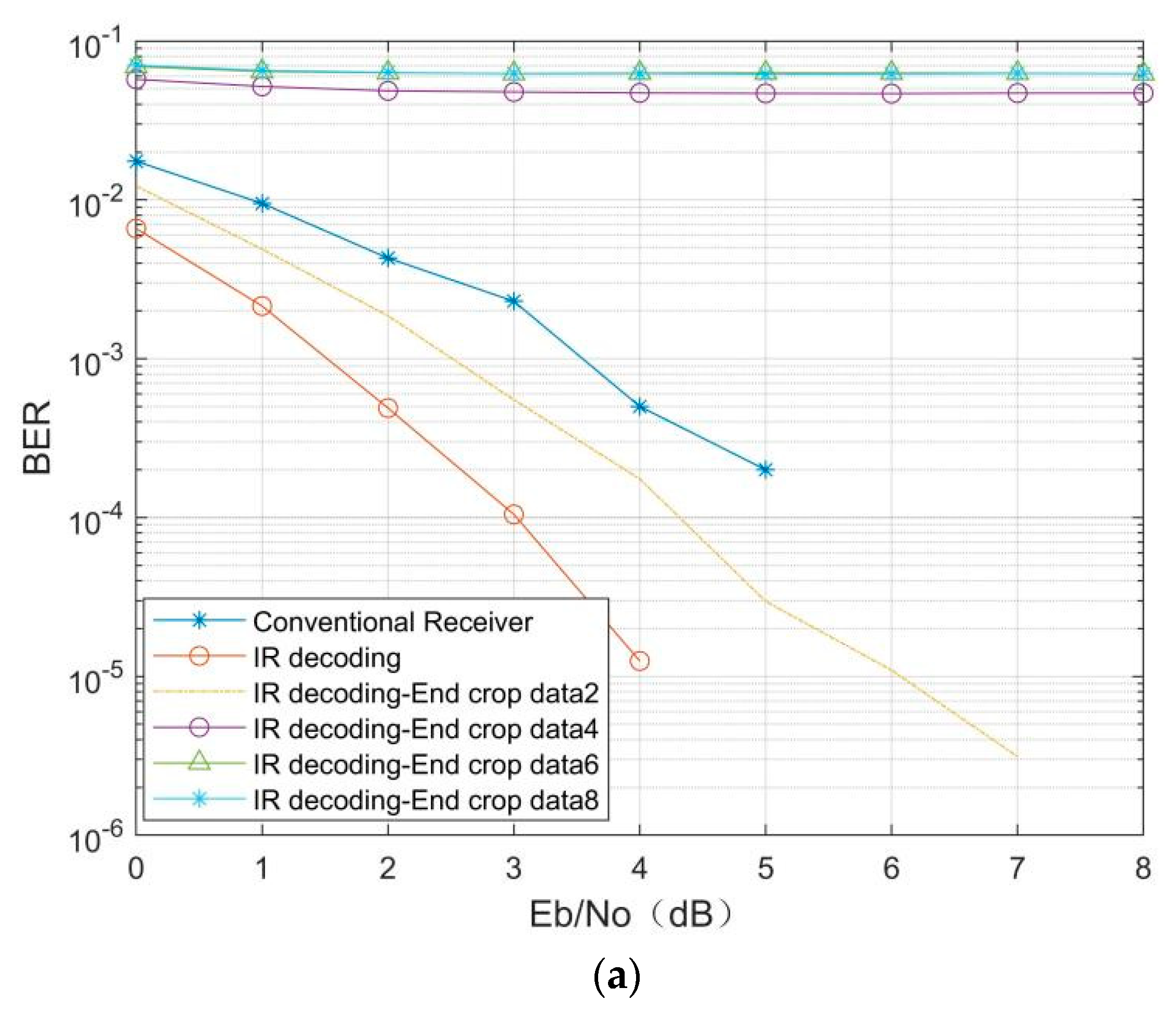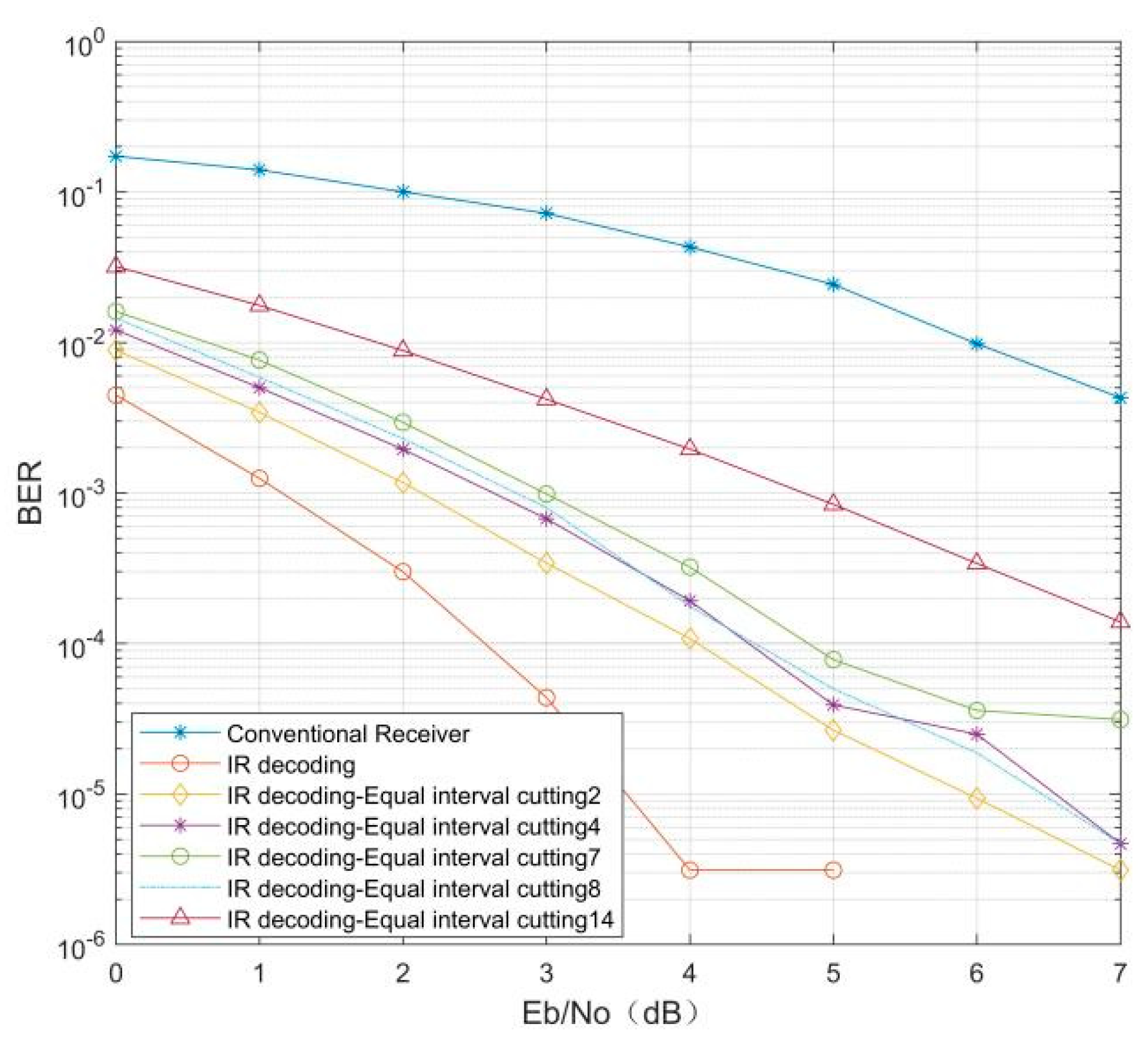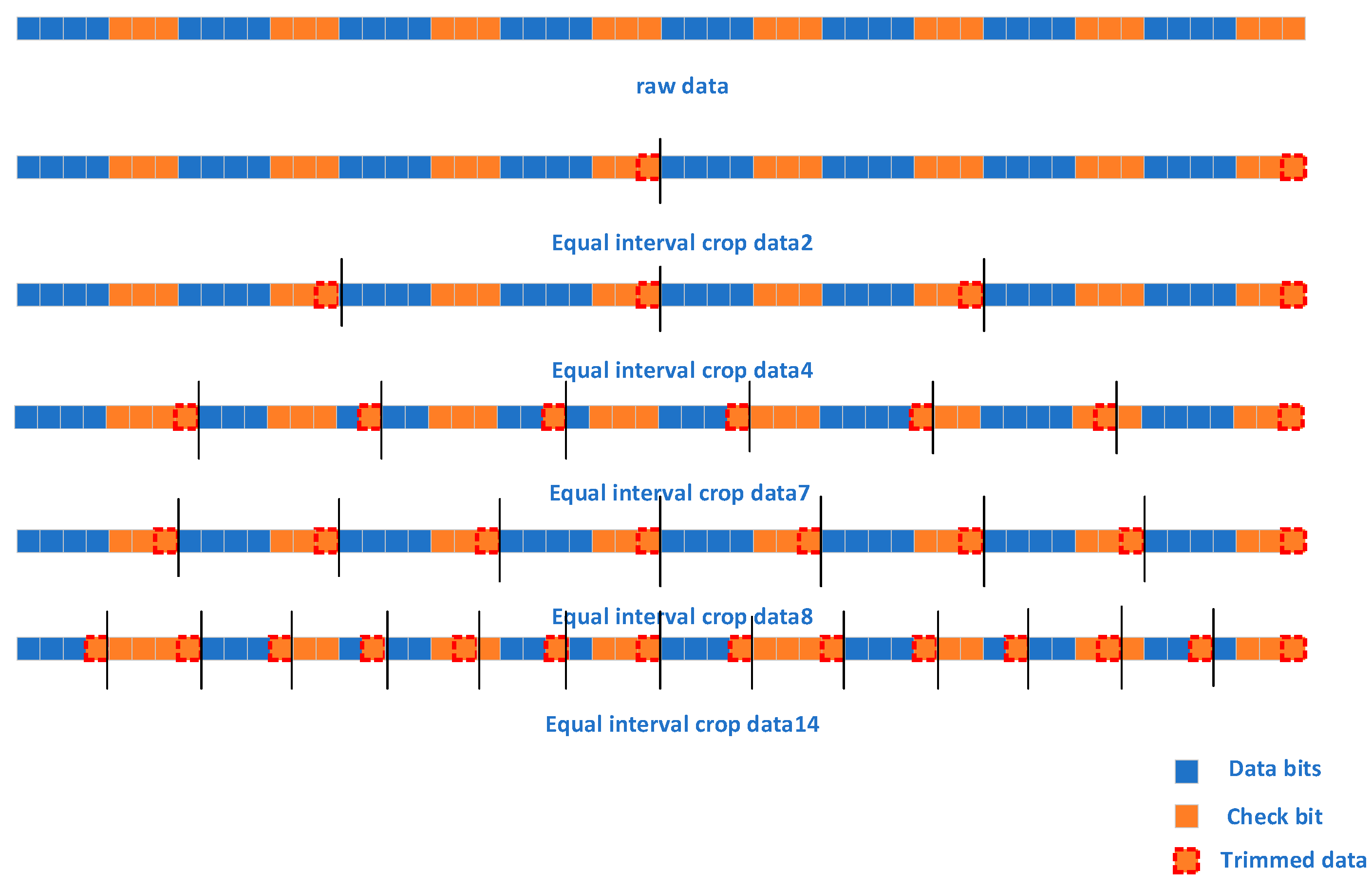1. Introduction
With the in-depth study of communication theories such as channel coding [
1,
2], and channel estimation [
3,
4], system capacity has gradually approached the Shannon limit [
5]. Moreover, the wide application of different communication technologies will generate a large amount of data, which are needed to support large-scale connections in the limited spectrum of resources and to maintain a lower delay, which pose challenges to traditional communication systems [
6].
Along with the wide application of deep learning (DL) algorithms in many fields, such as natural language processing (NLP) [
7,
8] and image processing [
9,
10], researchers are increasingly interested in applying deep learning algorithms to wireless signal processing. Some research has been undertaken to implement some of the functions of communication systems through deep learning algorithms, while some research has also realized the function of some modules of communication systems by deep learning algorithms. For example, by replacing the channel estimation module in orthogonal frequency division multiplexing (OFDM) systems by deep learning image processing techniques [
11]. Pu et al. [
12] used a deep learning algorithm to deal with serious channel damage in indoor visible light communication (VLC). Moreover, there are some studies that optimize receiver module processing by deep learning algorithms to improve the performance of communication systems. As long as the proper training is performed, they all outperform conventional receivers [
13,
14,
15].
Other researchers have considered replacing all modules at the receiving end of the communication system through deep learning algorithms to design an end-to-end intelligent receiver (IR). Among them, Hao Ye et al. [
16] have carried out some pioneering work in this area, where they used a fully connected network to implement the channel estimation and channel detection part of an OFDM communication system. The simulation results showed that the deep learning-based approach could implement the entire process of decoding at the receiver side of conventional communication with a performance comparable to that of the minimum mean square error estimator. Gao X et al. [
17] proposed a model-driven receiver, which combined deep learning with expert knowledge to replace the conventional OFDM system receiver. Different from the design of Hao Ye et al., which used a block-by-block signal processing approach, the receiver consisted of a two-part network of channel estimation and channel detection, and each sub-network was constructed by a deep neural network (DNN) and initialized using existing simple and conventional solutions. The simulation results showed that the algorithm had a lower bit error rate at a low signal-to-noise ratio, and the computational complexity and decoding accuracy of the algorithm were better than those proposed by Hao Ye et al. Zheng et al. [
18] designed different end-to-end receiver models, which extracted the features of input signals through 1D dense neural networks, and which used multiple binary classifiers in the final classification layer to achieve a bit by bit information flow recovery. The simulation results showed that the depth receiver was superior to the traditional hard decision method in terms of the bit error rate in a variety of different channel environments.
These previous works have shown that receiver models constructed by combining deep learning algorithms with traditional communications have better performances than traditional receivers. For the research of an intelligent receiver or replacing a communication module by deep learning, the received data is the same as that of a traditional receiver, and the performance of the receiver is evaluated by comparing the bit error rate (BER) or symbol error rate (SER); however, there is little research on whether the intelligent receiver can achieve accurate decoding by reducing the data at the transmitter. Although a variety of different semantic communication models have been designed [
5,
6], this improves the communication efficiency and significantly reduces the transmitter data. Unlike the improvement of source coding in semantic communication, there is, however, less research on whether an end-to-end intelligent receiver has the ability of accurate decoding after reducing the data at the transmitting end after source coding. In other words, there is little research on whether an end-to-end intelligent receiver has a similar semantic communication ability to reduce the data of the transmitter.
Therefore, this paper will investigate whether the IR model under data reduction at the transmitter side of the multiple input multiple output (MIMO) communication system has the capability of accurate decoding. In this study, we designed two different data clipping methods to reduce the data at the transmitter. At the same time, we built the intelligent receiver network as seen in the literature [
18] to explore the performance of intelligent receivers under different scenarios of reducing transmitter data. Our contributions are as follows:
To the best of our knowledge, this is a preliminary investigation of whether the intelligent receiver has an accurate decoding capability with reduced data at the transmitter side.
We demonstrate that the intelligent receiver has the ability to decode accurately even with reduced data at the transmitter, and that the BER of the intelligent receiver decoding is lower than that of conventional receivers.
By verifying the effects of two data reduction methods, namely, data end cropping and data equal interval cropping, on the decoding capability of the intelligent receiver, we find that data equal interval cropping has little effect on the decoding performance of the intelligent receiver, and the intelligent receiver can achieve accurate decoding.
The rest of this paper is organized as follows.
Section 2 introduces the composition of the MIMO and the intelligent receiver network model.
Section 3 describes the idea of data clipping at the transmitter.
Section 4 explores the decoding performance of the intelligent receiver under different clipping data, and analyzes different clipping methods. Finally,
Section 5 concludes this paper and briefly describes future work.
3. Transmitter Data Clipping
The MIMO system shown above can be simplified into the basic framework shown in
Figure 6 below. The original bit data is encoded by the source, transmitted to the wireless channel after the channel coding, and then decoded by the corresponding receiver. When the mode of the source coding and channel coding is not considered, the process of the source coding and channel coding can be further simplified into the following formula:
In the above equation,
and
represent the source coding and channel coding processes, respectively. The data sent by the transmitter can be further expressed as the following equation:
With the rapid development of communication system theory, source coding improves the effectiveness of information transmission, and channel coding improves the reliability of communication. The original bit data is sent to the channel after being converted by a rigorous formula. The architecture of the receiver of the communication system is shown in
Figure 7 below.
As shown in
Figure 7a, the conventional receiver mainly includes channel decoding and source decoding in the decoding process. The model shown in
Figure 7b is an intelligent receiver model. Compared with the traditional receiver with a detailed formula derivation to realize the decoding, the intelligent receiver model often uses the strong nonlinear data fitting ability of a convolutional neural network (CNN), long short-term memory (LSTM) and other deep learning networks to decode the received data.
Another reason why the intelligent receiver can decode accurately is that the data at the transmitter side is derived by a rigorous formula, and the data input to the neural network still has a certain regularity even under the noise interference, so that the neural network can realize the process of channel decoding and source decoding at the same time after significant training, and then complete the decoding. Taking the intelligent receiver based on a CNN designed in the literature of [
18] as an example, which converts IQ data into a one-dimensional matrix input to the network, it achieves the extraction of the input data features through a densely connected convolutional network (DenseNet), and sets multiple binary classifiers in the fully connected layer to achieve the bit-by-bit recovery of the original bit signal. In the task of image classification or reconstruction by a CNN, the image an often pre-scaled to maintain the same size. In addition, as shown in
Figure 8a, the CNN can still recognize the animal “sheep” in the image by cutting the image. In the task of image recognition, the size of an image is reduced by reducing and cropping the image, and the CNN model still has the ability to recognize graphic information. The CNN-based decoding mode adopted in the literature of [
18] is the same as the principle of image recognition and the classification task. The CNN can still realize decoding after cutting the image. Consequently, for receivers using the same model, as shown in
Figure 8b, we will now explore whether the intelligent receiver model designed based on a CNN has an accurate decoding capability when reducing the data at the transmitter of the communication system.
Unlike the image data reduction method, in order to reduce the IQ data sent by the transmitter in the communication system, this study only considers reducing the data at the transmitter through clipping. Additionally, where end cropping is the simplest way to reduce the data, this paper proposes an equal interval reduction in the launch data. Assuming that the length of the data
at the transmitting end is eight and the data is trimmed at equal intervals of four bits, the trimmed data is
. The trimming process can be realized as shown in
Figure 9. The trimmed data s is expressed as follows by the formula:
in the above equation indicates that
is cropped at equal intervals through the matrix shown in
Figure 9. Previous research work, such as in the literature of [
18], has shown that intelligent receivers have the ability to extract the original bit information from the transmitter-side data that is interfered by the channel. For equidistant clipping, combining Formula (8) with
Figure 9, we find that the process can be realized by relevant formulas, and that the data after the equidistant clipping still retains a certain regularity. Moreover, the data at the transmitter side is reduced in an orderly manner, i.e., for the intelligent receiver the inputs are changed in an orderly manner and the equal-interval cropping retains a large amount of information. Therefore, when the data at the transmitting end decreases in order, we believe that under the condition of strong nonlinear fitting of the receiving neural network, it can recover the original data by finding the relationship between the clipped data and the original binary bit data.
4. Simulation Result
In this section, we will explore whether the intelligent receiver had the performance of accurate decoding when the data at the transmitter side was reduced in the communication system. For this reason, we designed two ways to reduce the data at the transmitter side, namely, data end cropping and data equal interval cropping, for multiple input multiple output MIMO systems.
In the experimental setup of the communication system, we used the MIMO communication system similar to that in document [
18]. At the transmitter side, the original number of binary bits was 32, first (7, 4) with Hamming coding, a modulation method using BPSK modulation, after a modulation of the signal into the STBC coding module, then after Alamouti space-time coding to form a two-way length of 56 code streams. An up sampling module was set at the receiving end, and the number of sampling points of each symbol was 8.
The design of the intelligent receiver was the same as in the literature of [
18], where the receiver input data was the IQ data arriving at the receiver after channel interference and the output data was the original 32-bit length binary bit data.
First, we explored whether the intelligent receiver had an accurate decoding ability when reducing the data at the transmitter in the AWGN channel. In this experiment, the data after the STBC encoding was end-cropped and the data was reduced in the process shown in
Figure 10a. The original transmitter sent data as a two-way code stream of length 56, and the data length of each stream was cut from the end to 2, 4, 6 and 8, respectively. There were two reasons for conducting the end data cropping experiment first. On the one hand, end cropping is the easiest way to implement data cropping. On the other hand, when the end clipped data is small (e.g., the cropped data length is two), if the intelligent receiver can achieve accurate decoding, it will provide a theoretical basis for the later, equally-spaced data clipping, i.e., when there is a small amount of data reduction, while the depth receiver still has the ability to accurately decode.
The results of the clipping experiment at the end of the transmitter data are shown in
Figure 11a below.
With the increase in clipped data at the end of the data, the decoding accuracy of the intelligent receiver decreased. When the clipped data at the end was two, it could be observed that the BER of the intelligent receiver was between the decoding BER of the deep receiver under the complete data and the decoding BER of the traditional receiver. This shows that the intelligent receiver still had a certain decoding ability when the data was reduced in a small amount, and the intelligent receiver could accurately complete the decoding through the nonlinear fitting ability of the neural network. Moreover, its decoding performance was better than the traditional decoding methods. When the end data cropping exceeded two, the decoding BER of the intelligent receiver was higher than that of the conventional receiver, which indicates that as the end cropped data increased, the missing information increased and the receiver was unable to extract features from the missing data; therefore, its decoding capability decreased.
Then, the reasons for the receiver’s inability to decode accurately when the end-crop data lengths were 4, 6, and 8 were investigated. Since the receiver in the literature of [
18] used bit-by-bit decoding, when the intelligent receiver input data with end-crop data lengths of 4, 6, and 8, the last 3 bits of the end of the output data were removed, and only the decoding ability of the intelligent receiver for the first 29 bits of the binary bit data was investigated when the end-crop was applied. From
Figure 11b, we can find that the smart receiver decoding capability approximated the decoding performance with no data cropping, which indicates that the smart receiver could extract information from the missing data for a bit-by-bit recovery when the data was cropped at the end of the transmitter. In addition, for the reduced data at the transmitter side, which contained information from the original binary bit data, the intelligent receiver decoding could not accurately decode the missing part of the data when the number of cuts was high. For the un-missing data, its decoding performance was close to that of the intelligent receiver under the complete data. The above experimental results provide a basis for the subsequent equally-spaced tailoring of the data at the transmitting end. When the number of the transmitter data was reduced by a small amount (e.g., trimmed data two in
Figure 6a), the intelligent receiver still had the ability to extract information from the missing data to achieve accurate decoding.
In the Rayleigh channel, we cut the data at equal intervals as shown in
Figure 10b, and cut the data length into 2, 4, 7, 8, and 14. Taking the cropped data length of 2 in
Figure 10b as an example, for a stream of length of 56, it was first divided into two equal parts, and then the end data was cropped by 1. For the other stream, the settings were the same as the above to ensure that the intelligent receiver could extract the data features at the same location.
The simulation results are shown in
Figure 12 below. When the number of the data cropping was 4, 7 and 8, the decoding performance of the intelligent receiver was close and its decoding performance was much better than that of the conventional receiver. Comparing the cropping number length of 7, and 8, it can be observed that the BER of cropping number 8 was lower than that of cropping number 7. By observing the comparison of the cropped data in
Figure 13, we can find the reason for this phenomenon. When the equal interval cropping was performed, the data and parity bits were cropped when the cropped data length was 7, while only the parity bits were cropped when the cropped data length was 8; therefore, the BER of the cropped data length 8 was lower than that of the cropped data length 7. An extreme example was the cropped data length of 14. We can observe that the check bits and data bits containing information in the original data were heavily and regularly cropped; therefore, the receiver decoding effect was the worst when the cropped data length was 14, but its decoding performance was still better than the traditional decoding method, which indicates that the intelligent receiver still had the ability to decode accurately even if the data bits containing information were cropped during the equally-spaced data cropping process. In addition, comparing
Figure 11 and
Figure 12, although there were differences in the channels, it can still be found that when the data were cropped by the same number, split cropping had a great advantage over end cropping. The reason for this is that split cropping is more regular compared to the end cropping method, and for intelligent receivers, it is easier to extract features from the data to achieve accurate decoding.
5. Conclusions
A large amount of data transmission is one of the challenges of communication systems, and this paper explored whether an intelligent receiver with reduced transmit-side data had the ability to recover data accurately. It was concluded that the communication system consisting of intelligent receivers, not only has the advantage of a low BER, but also has another advantage of reducing the data at the transmitting end. In other words, a communication system consisting of end-to-end intelligent receivers has the same advantage as semantic communication, i.e., a reduction in transmit-side data, which provide new ideas for reducing the amount of data transmitted by a system. In addition, unlike semantic communication that optimizes coding to reduce the transmit-side data, end-to-end smart receivers achieve a transmit-side data reduction by a simple cropping of the data after channel coding.
To demonstrate that an end-to-end intelligent receiver still has the ability to decode effectively with reduced transmit-side data, we proposed two ways to reduce the transmit-side data, namely, a transmit-side data end-crop and an equal-interval data cut, and we verified that the receiver has the ability to decode accurately when a small amount of transmit-side data is end-cropped, but the receiver decoding ability decreases as the number of cuts increases. In contrast, for the equal-interval cropping of data, the receiver has the ability to recover the original information bits from the cropped data. With equal-interval cropping, the receiver still has a high decoding performance while reducing the data at the transmitter side, and this performance is better than the conventional decoding method.
The next work will investigate whether the receiver has the ability to decode accurately under data cropping using different coding methods, such as BLAST, STTC and differential space-time coding in MIMO systems. In addition, the optimal data cropping method corresponding to different channel coding methods, and the optimal data cropping size corresponding to the current cropping method, will be continued to be investigated.

